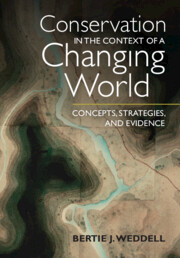Book contents
- Conservation in the Context of a Changing World
- Conservation in the Context of a Changing World
- Copyright page
- Dedication
- Contents
- Preface
- Acknowledgments
- Introduction
- Part I Maintaining Populations of Featured Species: A Utilitarian Approach to Conservation
- 1 Historical Context
- 2 Central Concepts
- 3 Strategies
- 4 Strategies
- Part II Protecting and Restoring Populations and Habitats: A Preservationist Approach to Conservation
- Part III Promoting Biocultural Diversity and Resilience: A Stewardship Approach to Conservation
- Postscript
- Appendix: Types of Ecosystems
- Bibliography
- Index
2 - Central Concepts
Populations, Succession, and Ecosystems
from Part I - Maintaining Populations of Featured Species: A Utilitarian Approach to Conservation
Published online by Cambridge University Press: 28 September 2023
- Conservation in the Context of a Changing World
- Conservation in the Context of a Changing World
- Copyright page
- Dedication
- Contents
- Preface
- Acknowledgments
- Introduction
- Part I Maintaining Populations of Featured Species: A Utilitarian Approach to Conservation
- 1 Historical Context
- 2 Central Concepts
- 3 Strategies
- 4 Strategies
- Part II Protecting and Restoring Populations and Habitats: A Preservationist Approach to Conservation
- Part III Promoting Biocultural Diversity and Resilience: A Stewardship Approach to Conservation
- Postscript
- Appendix: Types of Ecosystems
- Bibliography
- Index
Summary
Utilitarian conservation focuses on a few ecological processes: population regulation in resource-limited systems, succession, predation, and competition. This approach assumes that nature tends toward equilibrium. According to this balance-of-nature mindset, populations are regulated by density-dependent processes. Exponential population growth can generate high numbers quickly, but competition for limiting resources generally keeps populations near the carrying capacity of their environment. In the absence of predation, however, populations may erupt, deplete their food supply, and crash. Similarly, plant associations go through predictable sequences of seral stages culminating in stable climatic climaxes that are able to reproduce themselves indefinitely unless in the absence of disturbances such as fire. Plant associations are groups of interdependent species that all react in the same way to their environment. Utilitarian conservation focuses on keeping populations of economically valuable species such as game animals and commercially harvested trees in balance with their environment.
Keywords
- Type
- Chapter
- Information
- Conservation in the Context of a Changing WorldConcepts, Strategies, and Evidence, pp. 38 - 63Publisher: Cambridge University PressPrint publication year: 2023

